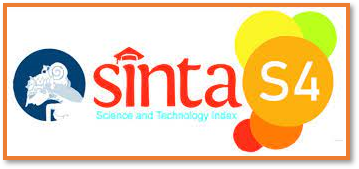Pengaruh Penggunaan Erless (Edema Reduction Leg Elevator Stainless Steel) 30° Dan 45° Terhadap Sirkulasi Perifer
Abstract
Latar Belakang: ERLESS (Edema Reduction Leg Elevator Stainless Steel) didesain sebagai elevator untuk menurunkan edema pada pasien Ulkus Kaki Diabetik(UKD). Penelitian sebelumnya menunjukan elevasi sangat efektif untuk menurunkan edema dan meningkatkan penyembuhan luka tetapi belum menilai dampak elevasi terhadap sirkulasi perifer. Penilaian sirkulasi perifer yang efektif dengan metode noninvasive dilakukan melalui pengukuran Ankle Brachial Index (ABI). Tujuan penelitian: menganalisis pengaruh elevasi ekstremitas bawah pada sudut 30° dan 45° dengan menggunakan ERLESS (Edema Reduction Leg Elevator Stainless Steel) terhadap sirkulasi perifer. Metode: Quasy eksperiment, pendekatan pre post test control group design, Sampel 30 responden. Teknik sampel menggunakan consecutive sampling. Responden dipasang ERLESS pada kelompok perlakuan elevasi 30° dan 45° kelompok kontrol dengan posisi kaki datar (tanpa ERLESS). Elevasi selama 15 menit. Sebelum dan sesudah elevasi semua kelompok diukur ABI. Uji statistik paired t-test, One Way Anov. Hasil: Nilai sirkulasi perifer melalui pengukuran ABI pada kelompok 30° nilai p=0.026, kelompok 45° nilai p=0.035, dan kelompok kontrol nilai p=0.136. Selisih sirkulasi perifer melalui pengukuran ABI pada kelompok 30° dibandingkan kelompok kontrol nilai p=0.012, kelompok 30° dibandingkan kelompok 45° nilai p=0.729 dan kelompok 45° dibandingkan dengan kontrol masing-masing nilai p=0.005. Kesimpulan: Elevasi 30° dan 45° efektif meningkatkan sirkulasi perifer. Melakukan penelitian sirkulasi perifer menggunakan ERLESS dengan sudut berbeda dan pada penyakit gangguan sirkulasi perifer.
Kata Kunci: Elevasi, Ankle Brachial Index, Sirkulasi PeriferFull Text:
PDFReferences
Aalaa, M., Malazy, O. T., Sanjari, M., & Peimani, M. (2012). Nurses ’ role in diabetic foot prevention and care; a review, 1–6.
Adabiah.(2014). Hubungan dukungan keluarga dengan harga diri pada pasien ulkus diabetikum di ruang rawat inap Penyakit dalam RSUP Dr. M. Jamil Padang.Thesis. Universitas Andalas Sumatera Barat. Padang. di akses tanggal 25 Juni 2015 dari http//:www.repo.unand.ac.id
Alligood, M. R. (2014). Nursing Theorists and Their Work (Eighth). St. Louis, Missouri: Elsevier Inc and Mosby,inc. diakases tanggal 1 Februari 2015 dari http://www.elsevier.com and www.bookaid.org.
Armstrong, D. G., & Lipsky, B. A. (2005). Preventing Foot Ulcers, 293(2), 217–228.
Armstrong, D & Rilo, H. (2010). Use of Sugar on the Healing of Diabetic Ulcers : A Review, 4(5), 1139–1145.
Ayana A. Goddard, MS, Carolyn S. Pierce, DSN, RN, and Kenneth J. McLeod, PhD.(2008). Reversal of Lower Limb Edema by Calf Muscle Pump Stimulation. Journal of Cardiopulmonary Rehabilitation and Prevention 2008;28:174–179.
Balasudaram Jeyakhanthan.(2006). The reliability of Foot and Ankle Water Volumemetry. Thesis. Master of Health Science Auckland University of Technology.Aucland.
Brodovicz, K. G., McNaughton, K., Uemura, N., Meininger, G., Girman, C. J., & Yale, S. H. (2009). Reliability and feasibility of methods to quantitatively assess peripheral edema. Clinical Medicine & Research, 7(1-2), 21–31. diakses tanggal 2 Februari 2015 dari http://www. doi.org/10.3121/cmr.
Byung-Hee & Hae Young Lee. (2010). Angging and Arterial Stiffness. Circulation Society. 74:2257-2262. diakses tanggal 28 Desember 2015 dari http://www.j-circ.or.jp. 20 Oktober 2015.
Chang, K. S. P. and A. V. and E. T. E. (2004). Costs of Lower-Extremity Ulcers Among. DIABETES CARE, 27(9).
Chadwick, P., Edmonds, M., McCardle, J., & Armstrong, D. (2013). International best practice guidelines: wound management in diabetic foot ulcers. Wounds Int, 4, 1-20.
Collins, L., & Seraj, S. (2010). Diagnosis and Treatment of Venous Ulcers, 81(8), 989–996.
Cesarone MR, Belcaro G, Nicolaides AN, Arkans E, Laurora G, De Sanctis MT, Incandela L.(1999). The edema tester in evaluation of swollen limbs in venous and lymphatic disease. Panminerva Med 1999;41:10-14.
Ely, J. W., Osheroff, J. A., Chambliss, M. L., & Ebell, M. H. (2006). Approach to Leg Edema of Unclear Etiology. The Journal of the American Board of Family Medicine, 19(2), 148–160. http://www.doi.org/10.3122/jabfm.
Elizabet B Simon. (2014). Leg edema, assessment and management.MEDSUR nursing. Vol 23 no.1.
F P Dix. (2005). Effect of leg elevation on healing. South Manchester: Sage Journal Phlebology.diakses tanggal 20 Juli 2015 dari http://www.phl.sagepub.com/content/20/2/87.abstract.
Frykberg, R. G. (2002). Diabetic foot ulcers: pathogenesis and management. American family physician, 66(9), 1655-1662. Diakses tanggal 27 Februari 2016 dari http://europepmc.org/abstract/med/12449264.
Greer, N. L. (2012). Advanced wound care therapies for non-healing diabetic, venous, and arterial ulcers a systematic review. United States: Washington, DC : Department of Veterans Affairs, Health Services Research & Development Service, 2012. diakses tanggal 21 Juli 2015 dari http://www.ncbi.nlm.nih.gov/books/NBK132238.
Guyton AC dan Hall JE. (2014). Buku Ajar Fisiologi Kedokteran. Edisi 11. Jakarta. EGC.
Hariani Lynda & Perdanakusuma David.(2013). Perawatan Ulkus Diabetes. Program Pendidikan Dokter Spesialis Ilmu Bedah Plastik Fakultas Kedoteran Universitas Airlangga Surabaya. diakses tanggal 18 November 2015.http//www.journal.unair.ac.id.filePDF.
Heather Herdman, S. K. (2014). Nanda International Nursing Diagnoses: Definitions & Classification 2015–2017. Igarss 2014 (Tenth). Oxford: Wiley Blackwell. diakses tanggal 2 April 2015 dari http://www.doi.org/10.1007/.
Herawati.(2015). Indikator Pelayanan Prima Rumah Sakit Umum Daerah. diakses 20 November 2015 dari http//www.indicator-palayanan-prima-rumah.
Hidayat Achmad, (2000). Pengaruh umur, Diabetes Mellitus dan Hipertensi terhadap terjadinya infeksi luka operasi pasca Transvesikal Prostatektomi. Fakultas Kedokteran Universitas Diponegoro Semarang. diakses tanggal 23 Mei 2016 dari http//www. eprint.undip.ac.id.thesis.
Ho, T. K., Leigh, R. D., & Tsui, J. (2013). The British Journal of Diabetes & Vascular Disease Diabetic foot disease and oedema. The British Journal of Diabetes & Vascular Disease, 13: 45. diakses tanggal 2 Juli 2015 dari http://www.doi.org/10.1177/1474651412472213.
Irawati Lilik. (2010). Viskositas darah dan Aspek Medisnya. Majalah Kedokteran Andalas No.2. Vol.34. Juli-Desember 2010.
Jain, A. K. C. (2012). A new classification of diabetic foot complications: a simple and effective teaching tool. The Journal of Diabetic Foot Complications, 4(1), 1–5.
Karnarius Harefa dan Artika Sari.(2011). Pengaruh Senam Kaki Terhadap Sirkulasi Darah Kaki Pada Pasien Diabetes Melitus Di Ruang Penyakit Dalam RSU Dr. Pirngadi Medan Tahun 2011
Kamus Besar Bahasa Indonesia. (2016). Kamus Beser Bahasa Indonesia. diakses tanggal 14 Februari 2015 dari http://www.kbbi.id.
Kawasaki, T. (2013). The effect of different positions on lower limbs skin perfusion pressure. Indian J Plast Surg. 2013 Sep-Dec. diakses tanggal 20 Mei 2015 dari http://www.doi.org/10.4103/0970-0358.121995.
Kozier. (2011). Buku Ajar Fundamental Keperawatan: Konsep, Proses dan Praktik, Penerjemah Widiarti. Jakarta: EGC.
Lalithambika, Saraswati, Nisha, Varma Kumar Ajit, Jose Amrutha dan
Sudaram (2014). Ankle Brachial Index and Transcutaneous Partial Pressure of Oxygen as predictors of wound healing in diabetic foot ulcers. The Journal of Diabetic Foot Complication; Volume 6, Issue 2, No.4 page 54-58.
Le Gare Stephanie, Charles Gammal Erika Hall,Rachelle Horwitz.( 2007),A Device For Measuring The Severity Of Peripheral Edema. Faculty of Worcester Polytechnic Institute.Worcester.
Liaw MY, W. M. (1989). The effects of leg elevation to reduce leg edema resulting from prolonged standing. PubMed - indexed for MEDLINE. diakses tanggal 2 Mei 2015 dari http://www.doi.org/2794965.
Lyder, C. H., & Ayello, E. A. (2005). Pressure Ulcers: A Patient Safety Issue. Chapter 12.
MacGregor, L. (2010). International Review. Pressure ulcer prevention, pressure, shear , friction and microclimate in context. A consensus document. Wound International Enterprise House.
Melila, Lucas KRT & Suryamiharja, A. (2007). Penuntun Penatalaksanaan Nyeri Neuropatik. Yogyakarta: Medikagama Press.
Monnet Xavier, Richard, Teboul Jean Louis.(2015). Passive Leg Raising: five rules, not a drop of fluid. Biomed Central.Paris.19:18.
Mora. (2002). The role of pulsatile cold compression in edema resolution following ankle fractures: a randomized clinical trial. Foot Ankle Int, 23, 999–1002.
Moffatt Christine. (2006). International concencus. Best Practice For The Management of Lymphoedema. Medical Education Patnership. London.
MR, Cesarone, Laurora G, De Sanctis MT, Incandela L, Steigerwalt R, B. G. (1999). The edema tester in the evaluation of swollen limbs in venous and lymphatic disease. Panminerva Med;41:10-14.
Nabuurs-franssen, A. M. H., & Kruseman, N. (2005). Health-related quality of life of diabetic foot ulcer patients and their caregivers. Diabetologia, 1906–1910. diakses 20 Maret 2015 dari http://www.link.springer.com/article
National Pressure Ulcer Advisory Panel, E. P. U. A. P. and P. P. P. I. A. (2014). Prevention and Treatment of Pressure Ulcers : Quick Reference Guide. ( Emily Haesler, Ed.). Perth, Australia: Cambridge Media.
Sugiyono.(2016). Metodologi Penelitian Kuantitatif, Kualitatif dan R & D. ISBN: 979-8433-64-0.Bandung. Alfabeta.
Sukmana, Mayusef.(2016). Penggunaan ERLESS 30° dan 45° terhadap circumference edema, kenyamanan dan fungsi pada Ulkus Kaki Diabetik di RS Samarinda. Tesis. Universitas Muhammadiyah Yogyakarta. Yogyakarta.
Supriadi., Nishizawa, T., Fukuda, M., Kon, Y., & Junko, M. (2014). Interface pressure , pressure gradient with pressure ulcer development in Intensive Care Units. Journal of Nursing Education and Practice.www.sciedu.ca/jnep, 4(9),146–154. diakses pada tanggal 28 Desember 2015 dari http://www.doi.org/10.5430/jnep.
Nursalam. (2009). Konsep dan Penerapan Metodologi Penelitian Ilmu Keperawatan Pedoman Skripsi, Tesis dan Instrumen Penelitian Keperawatan. (T. E. S. Medika, Ed.). Jakarta: Salemba Medika. diakses tanggal 20 Mei 2015 dari http://www.penerbitsalemba.com.
Oktavia.(2015).Ulkus Diabetic. diakses pada tanggal 21 November 2015 dari http://www.10/ulcus-diabetic.html/.
PERKENI.(2011). Konsensus Pengelolaan dan Pencegahan Diabetes Mellitus Tipe 2 di Indonesia.
Purnamasari, Endah dan Poerwantoro, Bambang. (2011). Majalah Kesehatan Pharma Medika, 2011 Vol.3. No. 2.
Paul, Chadwick, Edmonds M, McCardle J, A. D. (2013). International Best Practice Guidelines : Wound Management in Diabetic Foot Ulcers. Wounds International. London: Wounds International,. diakses tanggal 20 Mei 2015 dari http://www.woundsinternational.com/clinical-guidelines.
Prompers, L. and M. H. and N. S. and J. A. (2008). Resource utilization and cost associated with the treatment of diabetic foot ulcers. Prospective data from the Eurodiale Study. diakses pada tanggal 12 Mei 2015 dari http://www. doi.org/10.1007.
Quilici, B. C. E. (2009). Comparison of reduction of edema after rest and after muscle exercises in treatment of chronic venous insufficiency. International Archives of Medicine, 18, 1755–7682–2–18. diakses tanggal 20 Mei 2015 dari http://www.doi.org/10.1186.
Rebolledo, F. A., Soto, J. M. T., Escobedo, J., & Peña, D.(2011).The Pathogenesis of the Diabetic Foot Ulcer: Prevention and Management. Global Perspective on Diabetic Foot Ulcerations, 155–178.
Sherwood, Laurale. (2015). Fisiologi Manusia dari Sel ke Sistem.Edisi 8. Jakarta. EGC.
Sims, D. A. N. (1986). Effects of Positioning on Ankle Edema, 0–4. The Journal Of Orthopaedic And Sports Physical Therapy.Colombus. 0196-601 1 /86/801-0030.
Singh Simerjit, Pai Dinker, Yuhui Chew.(2013). Diabetic Foot Ulcer-Diagnosis and Management. Review article. diakses tanggal 3 Februari 2016, http://www.dx.doi.org/10.4172/2329-910x.1000120.
Starkey Chad. (2004). Therapeutic Modalities. (C. Frantantoro, Ed.) (3rd ed.). Philadelphia.: F.A. Davis Company.
Stems. (2014). Pathophysiology and etiology of edema in adults. diakses tanggal 28 Juli 2015 dari http://www.uptodate.com/contents/general-principles-of-the-treatment-of-edema-in-adults/contributors.
Sukmana, Mayusef (2016). Penggunaan ERLESS 30° dan 45° terhadap Circumference edema, kenyamanan dan fungsi pada ulkus kaki diabetik di RS Samarinda. Tesis. Universitas Muhammadiyah Yogyakarta. Yogyakarta
Suriadi. (2007). Manajemen Luka. Pontianak: Stikep Muhammadiyah.
Sussman, C & Swanson, G. (1997). Utility of The Sussman Wound Helaing Tool in Predicting Wound Outcomes in Phisical Therapy. Advances in Wound Care.
Takahashi., Black J., Dealey., Gefen.(2010) Pressure in Context. International Review. Pressure Ulcer Prevention pressure, shear, friction and microclimate in context.
Usatine, R. P. U. (2011). The color atlas of family medicine (2nd ed.). New York: McGraw-Hill Companies.
Usman.(2016). Modifikasi Modern Dressing dan Elevasi Ekstremitas Bawah terhadap Ankle Brachial Index (ABI) dan Skor Penyembuhan Luka Kaki Diabetik di Klinik Kitamura Pontianak.Tesis. Universitas Muhammadiyah Yogyakarta. Yogyakarta.
Villeco, J. P., & Otr, L. (2012). Edema : A Silent but Important Factor. Journal of Hand Therapy, 25(2), 153–162. diakses tanggal 28 Mei 2015 dari http://www.doi.org/10.1016/j.jht.2011.09.008.
WOCN.(2012). Ankle Brachial Index. Quick Reference Guide for Clinicians. Journal Wound Ostomy Continence, Nurs2012;39(25):S21-S29. Lippincott.Williams dan Wilkins.
Wulandari Indah. (2015). Pengaruh Elevasi Ekstremitas bawah terhadap proses penyembuhan UKD. Jurnal Ilmiah Keperawatan STIKES Hang Tuah Surabaya., 3.
Veves, Aristidis, Giurini John M dan Frank W. LoGerfo. (2006). The Diabetic Foot. Second Edition. Humana Press. New Jersey.
Yazdanpanah, L., Nasiri, M., & Adarvishi, S. (2015). Literature review on the management of diabetic foot ulcer. World Journal of Diabetes, 6(1), 37–53. doi:10.4239/wjd.v6.i1.37 diakses 25 Agustus 2015 dari http://www. ncbi.nlm.nih .gov/pmc/artic les /PMC4317316/.
Yoga, A. S. (2013). Perancangan Alat Bantu Penyangga Kaki Portabel untuk proses melahirkan. Yogyakarta.Skripsi. Program Studi Teknik Industri Fakultas Teknologi Industri Universitas Atma Jaya Yogyakarta. Yogyakarta.
Yotsu, R. R. (2014). Comparison of characteristics and healing course of diabetic foot ulcer by etiological classification: Neuropathic, ischemic, and neuro-ischemic type. Journal of Diabetes and Its Complications, Vol.28(4), 28;528–535. diakses tanggal 28 Mei 2015 dari http://www.doi.org/10.1016
DOI: http://dx.doi.org/10.30872/j.kes.pasmi.kal.v1i1.3619
Refbacks
- There are currently no refbacks.
Indexing by :










